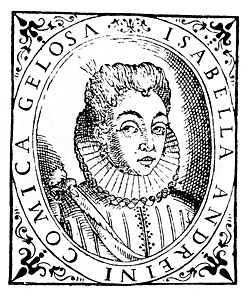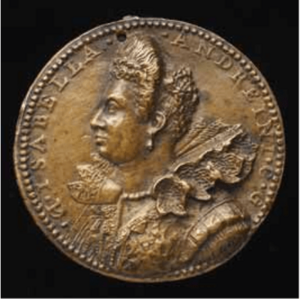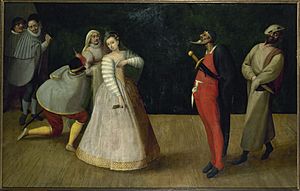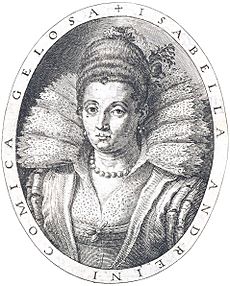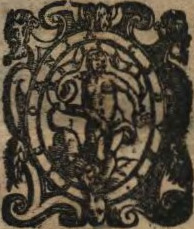Isabella Andreini facts for kids
Isabella Andreini (born Isabella Canali, 1562 – 10 June 1604) was a famous Italian actress and writer. She was also known as Isabella Da Padova. Andreini was a key member of the Compagnia dei Comici Gelosi, a well-known traveling theatre group that performed in Italy and France. The popular character of Isabella in commedia dell'arte plays was named after her.
Her Life and Career
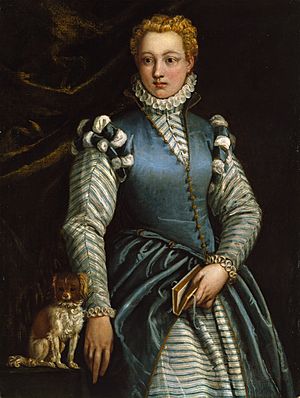
Isabella Canali was born in Padua, Italy. Her parents were from Venice. Even though her family was not rich, Isabella received a full education in classic subjects. She loved reading and writing and learned to speak several languages fluently. She used these language skills in her play La Pazzia d'Isabella (The Divine Madness of Isabella).
In 1576, when she was just fourteen, Andreini joined the theatre group led by Flaminio Scala, called the Compagnia dei Comici Gelosi. The Gelosi was a very respected theatre company that performed commedia dell'arte plays. These plays were popular with rich families in northern Italy and France. Henry III of France especially liked the group, and Andreini performed for him when she was very young.
From the start, Andreini often played the role of the prima donna innamorata, which means the leading lady in love. She was very good at making her characters more interesting and clever through improvising. She helped develop commedia dell'arte into a style of theatre known for its funny moments and spontaneous acting. She was one of the first women to become excellent at improvisation. She was known for her bold and expressive performances on stage. Andreini was also praised for how flexible she was as an actress, which was a very important skill for all commedia dell'arte actors. She understood her important role as a leading actress in a new kind of profession. Andreini stayed with the Gelosi company until she passed away.
In 1578, Andreini married Francesco Andreini. She took his last name, which was not common at the time. Francesco later became the director of the Gelosi company in 1589. Isabella became not only the main actress but also an important voice within the company. She worked with her husband to manage the group's activities and talk with people who wanted to support their shows.
Andreini had seven children—three boys and four girls—while touring with the Gelosi. She was a very dedicated mother. Her first son, Giambattista, followed in their footsteps and became an actor. Her other sons were raised by noble families in Mantua. One became a priest in an Italian monastery, and the other became a guard for a duke.
In 1589, Andreini performed her funny play La Pazzia d'Isabella (Isabella's Madness) for the court in Florence. This was during the wedding of Ferdinando I de' Medici and Christina of Lorraine. We still know many details about this mostly improvised play today. Because she spoke several languages, she was famous for her intelligent performances and graceful presence. In this play, she showed "madness" by using different languages and then copying the accents of other characters. She was very skilled and even said she could play any male role. Andreini was noted for playing three different characters in one scene, showing off her amazing improvisation skills and talent.
In 1599, Andreini performed for King Henry IV of France and his wife Marie de' Medici. By this time, Andreini was so famous that she was called the "star" performer of the group. Marie de' Medici even mentioned her in a letter as "the actress Isabella and her company."
Andreini also performed at least once for two other theatre groups: the Confidenti (of the Duke of Mantua) in 1589, and the Uniti in 1601.
In 1602, Andreini toured northern Italy. In 1603, she performed again for Henry IV, Marie de' Medici, and local audiences at Fontainebleau and Paris. This was her last tour. In early 1604, she passed away near Lyon, France, on her way back to Italy. She was 42 years old. After a public funeral, special coins were made to honor her. One side showed her as a powerful Roman ruler, and the other side showed the Roman goddess Fame with the words aeterna fama (eternal fame).
Even though Francesco Andreini ended the Gelosi company after Isabella's death, their son Giambattista Andreini, who was an actor and writer, started his own company called the Fedeli. He even used some of the original actors from the Gelosi.
Her Literary Works
Besides acting, Isabella Andreini was a respected intellectual who spent a lot of time on literature. The topics in her plays sometimes questioned the role of women in society at that time. She wrote with a strong voice that showed her good character. She is considered one of the most successful female writers of her time, partly because of her experience as an actress.
In a poetry competition held by Cardinal Giorgio Cinthio Aldobrandini of Rome, Isabella Andreini won second place. She was only beaten by the famous Renaissance poet Torquato Tasso. Other well-known poets like Gabriello Chiabrera and Giambattista Marino also praised her.
Some people even think that Andreini's writings were just as impressive, or even more impressive, than her acting performances.
Besides writing plays, Isabella also wrote poetry and exchanged letters with many different people.
Her Lasting Impact
Many poets, composers, and musicians honored Isabella Andreini after her death. Gherardo Borgogni, a poet, started writing poems praising Andreini early in her writing career. They exchanged poems for almost twenty years. These poems about Andreini later became lyrics for musical tributes. The first known musical tribute to Andreini was composed by Leone Leoni, who used Borgogni's poems. Other notable composers who honored her include Serafino Cantone, a Benedictine monk, and Peter Philips, an English composer. Andreini also inspired many French poets, like Isaac du Ryer.
Andreini was known for how well she connected with audiences on stage. She used complex characters to make them feel real and easy to relate to.
Andreini and Inglis (another famous French actress of the time) showed that women in the early modern period, who were not from noble families or very rich, could work and think across different countries and be respected for it. Both traveled widely and often. Andreini's acting job allowed her to travel even more frequently. Both became well-known among the cultural leaders of Europe.
The commedia dell'arte "lover" stock character, Isabella, was named after Andreini's most famous character. This character was then used by other commedia dell'arte groups. Theatre students have especially studied Andreini's works published after her death, Rime, Parte seconda and Fragmenti de alcune scritture.
Many women in early commedia dell'arte groups are credited with developing many of the improvisation techniques used in this art form. Andreini is part of this important legacy as a performer in the Gelosi troupe.
See also
 In Spanish: Isabella Andreini para niños
In Spanish: Isabella Andreini para niños
- Vittoria Piisimi


